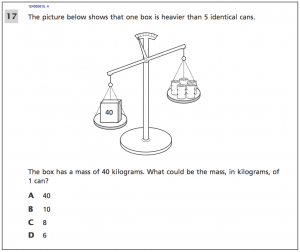I am going to recommend http://finance.yahoo.com/news/hardest-questions-3rd-graders-had-163000971.html for a take on current test wackiness. The New York State Education Department has historically given difficult tests and I am not surprised that only 36% of students passed the 2014 math exams. Those kids did better overall in math than reading, too. Only 31% of students passed the state reading exam. Here is a sample problem taken from the math test for the article.
Eduhonesty: Cripes. I’m not exactly negative on this problem. We need to find out where our students are operating on the learning curve and standardized tests should test the tails of the curve, exploring the limits of our strongest students. My concern focuses on the importance we are now placing on getting higher test scores on state tests. When only about one-third of test takers “pass” the test, we necessarily are making lots of eight-year-olds feel stupid.
My solution would be to scrap state tests, substituting computer-based, adaptive tests that start where the individual student left off on previous tests, offering harder or easier questions based on ongoing student responses. State tests are cumbersome instruments, only now being converted from bubbles on paper to computerized click and drag-and-drop versions. We used to give all students the same test because the logistics of adapting to individual students were too daunting to consider. But that adaptation has become entirely feasible today. We can track students’ past responses and keep these in available databases. We already have tests that change based on students’ responses.
Why do we need one test to rule them all? Individualized tests would provide more information. When a test is pitched too far above or below a student’s learning level, that test’s results often provide little information about what a student actually does know. Individualized tests would fill in the gaps in our understanding of academic mastery for our weakest and strongest students. Most importantly, those tests would allow students to see their progress more easily, while diminishing the discouragement created by unfortunate comparisons and harsh passing levels.



